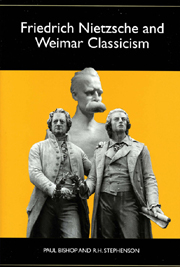Book contents
- Frontmatter
- Contents
- Dedication
- Acknowledgments
- A Note on Editions, Abbreviations, and Translations
- Introduction
- 1 Die Geburt der Tragödie and Weimar Classicism
- 2 The Formative Influence of Weimar Classicism in the Genesis of Zarathustra
- 3 The Aesthetic Gospel of Nietzsche's Zarathustra
- 4 From Leucippus to Cassirer: Toward a Genealogy of “Sincere Semblance”
- Appendix: The Composition of Zarathustra
- Bibliography
- Index
Introduction
Published online by Cambridge University Press: 05 February 2013
- Frontmatter
- Contents
- Dedication
- Acknowledgments
- A Note on Editions, Abbreviations, and Translations
- Introduction
- 1 Die Geburt der Tragödie and Weimar Classicism
- 2 The Formative Influence of Weimar Classicism in the Genesis of Zarathustra
- 3 The Aesthetic Gospel of Nietzsche's Zarathustra
- 4 From Leucippus to Cassirer: Toward a Genealogy of “Sincere Semblance”
- Appendix: The Composition of Zarathustra
- Bibliography
- Index
Summary
Meine allgemeine Aufgabe: zu zeigen, wie Leben Philosophie und Kunst ein tieferes und verwandtschaftliches Verhältniss zu einander haben können, ohne dass die Philosophie flach ist und das Leben des Philosophen lügenhaft wird.
[My general task is to show how life, philosophy, and art can have a deeper and familial relationship to each other, without philosophy being shallow and the life of the philosopher becoming untruthful.]
Nietzsche, 6[17]; KSA 8:104ACCORDING TO FRIEDRICH NIETZSCHE, the meaning of an object may be revealed by tracing its origin, which is uncovered by genealogy. Certainly, there has been no lack of studies placing him, genealogically, in relation to Immanuel Kant, Friedrich Wilhelm Joseph Schelling, Arthur Schopenhauer, Richard Wagner, and so forth, and this with good reason. In this book, we shall argue that the missing perspective, to use one of Nietzsche's favorite terms, is that of Weimar Classicism. When this perspective, the Kulturkampf or “cultural struggle” waged by Goethe and Schiller, is overlooked, the framework, and hence the structure, of Nietzsche's thinking is distorted to the point of unintelligibility. Once restored, however, this perspective opens up afresh the coherence and purposiveness in Nietzsche's philosophical aesthetics.
Friedrich Nietzsche's education at Schulpforta, where he studied from 1858 to 1864, gave him access to the world of the ancient classics, as well as to the Weimar classicists of the previous generation, Johann Wolfgang Goethe and Friedrich Schiller.
- Type
- Chapter
- Information
- Friedrich Nietzsche and Weimar Classicism , pp. 1 - 23Publisher: Boydell & BrewerPrint publication year: 2004



